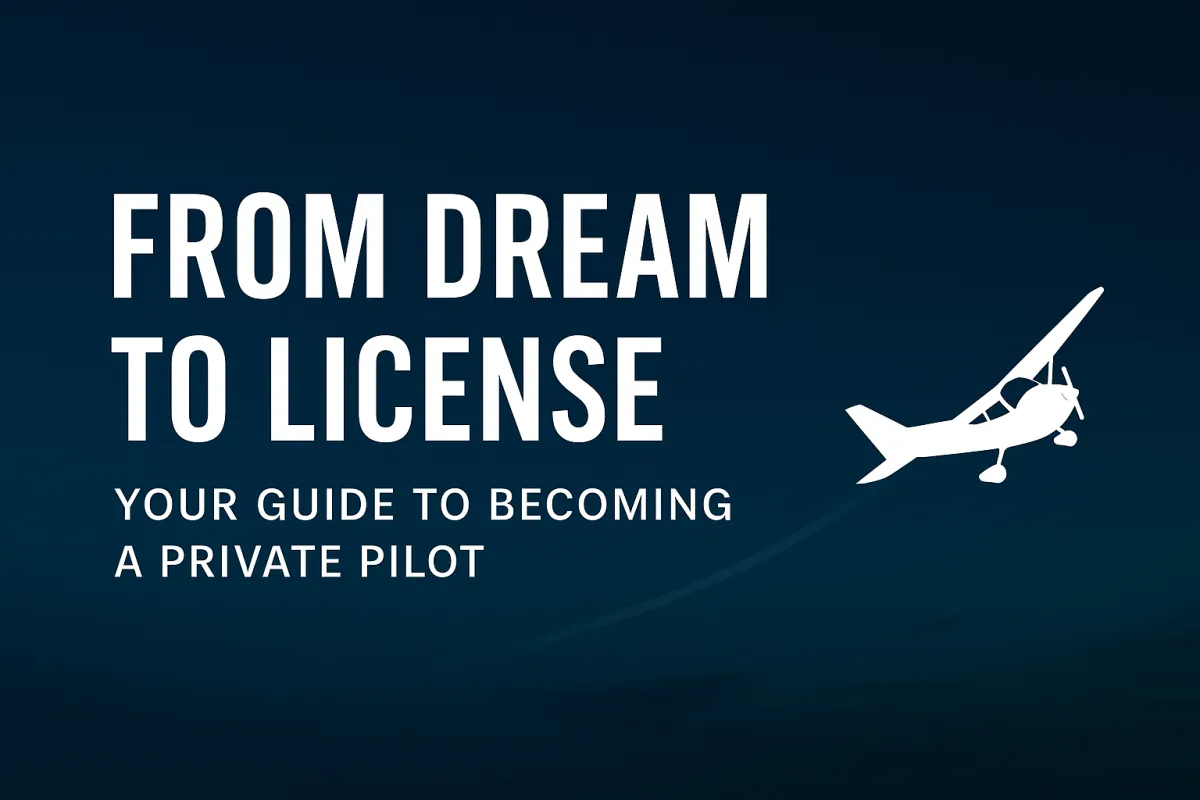
How to Go from Zero Experience to Private Pilot Certification
How to Go from Zero Experience
to Private Pilot Certification

For many aspiring aviators, the first spark is simple. Watching a small aircraft carve through the sky and wondering, Could I do that? The answer is yes! The path from that first moment of inspiration to becoming a licensed private pilot is more structured and attainable than most realize. This guide will walk you through every major phase in the journey, offering technical detail, estimated timelines, and decision points. All from a student's perspective.
Step 1: Meet the FAA Eligibility Requirements
Before stepping into a cockpit, you must meet a few basic prerequisites under 14 CFR §61.103:
Be at least 17 years old by the time of your checkride
Be able to read, speak, write, and understand English
Obtain an FAA Medical Certificate (at least Third-Class)
Complete ground and flight training with a Certified Flight Instructor (CFI)
Pass the FAA written knowledge test, oral exam, and practical flight test
You don’t need to own an aircraft, be a math whiz, or have prior flying experience. Just commitment, discipline, and the right support system.
Step 2: Begin Ground Training
Ground school provides the foundation for everything you’ll do in the cockpit. You’ll study topics like:
Aerodynamics and aircraft systems
FAA regulations and airspace structure
Meteorology and weather interpretation
Navigation using sectional charts and GPS
Weight and balance calculations
Aeronautical Decision Making (ADM)
Ground school may be delivered online, in a classroom, or as one-on-one sessions with your CFI. Most students use a mix of Self-study programs and Instructor-led Programs
Step 3: Begin Flight Training in a Training Aircraft
Your in-air training starts from your very first lesson. Your instructor introduces:
Preflight inspections and aircraft walkarounds
Taxiing, radio communications, and use of checklists
Basic attitude flying, climbs, descents, and turns
Takeoffs, landings, and traffic pattern procedures
Emergency procedures and stall recognition/recovery
A good training aircraft, such as a Cessna 172 or Piper Archer, should be equipped with modern avionics (e.g., Garmin G5 or G1000) and be rigorously maintained under 14 CFR §91.409.
👉 Explore modern aircraft ideal for student pilots at this rental fleet page
Step 4: Complete Your First Solo Flight
One of the most pivotal milestones is your first solo flight. Before it happens, your instructor will ensure you can safely:
Control the aircraft in takeoff and landing configurations
Navigate the traffic pattern
Communicate with ATC (if in controlled airspace)
Handle go-arounds and minor in-flight issues
Once endorsed under 14 CFR §61.87, you’ll perform three full stop landings without your instructor onboard, and you’ll never forget it.
Step 5: Cross-Country and Advanced Maneuvers
After soloing, your training will expand to:
Dual and solo cross-country flights (at least one 150+ NM trip with 3 landings)
Flight at towered airports, airspace navigation, and in-flight decision making
Night flight training (per §61.109)
Simulated instrument conditions, unusual attitude recovery, and radio navigation
You’ll also revisit all earlier maneuvers, stalls, steep turns, S-turns, slow flight, until you meet the Airman Certification Standards (ACS) for private pilot.
Step 6: Pass the FAA Written Exam
Before your final checkride, you must pass the FAA Private Pilot Knowledge Test, which covers:
Navigation and flight planning
Weather theory and decoding
Airspace and sectional charts
Performance calculations
Regulations and procedures
This is a 60-question multiple choice exam, with a minimum passing score of 70%. It must be completed before your practical test.
Most students pass on their first attempt when using guided ground training resources or working with their CFI on weak areas.
Step 7: Prep for and Complete the Checkride
The checkride is the final gate. It includes:
Oral Exam: Your FAA Designated Pilot Examiner (DPE) will ask scenario-based questions on airspace, weather, regulations, and flight planning.
Flight Test: You’ll perform a full range of maneuvers, cross-country navigation, and demonstrate emergency preparedness.
Expect to fly for 1.5 to 2 hours and show strong command of risk management, flight controls, and radio communication.
After you land and the DPE shakes your hand? You’re officially a Private Pilot, certified under 14 CFR §61.113 to fly passengers (but not for hire).
Typical Timeline and Costs
Most students complete training in 3–6 months, depending on schedule and weather. The FAA requires:
40 hours total time, including:
20 hours dual instruction
10 hours solo flight
5 hours cross-country
3 hours night
3 hours instrument
Realistically, most students take 55–70 hours to feel fully prepared. Cost varies by location and aircraft type but typically ranges between $12,000–$16,000 for a complete program.
👉 See estimated training packages here: Private Pilot Program Info
Step 8: Stay Proficient and Expand Your Skills
Your license never expires, but currency matters. To carry passengers, you must log:
3 takeoffs and landings within the past 90 days
1 hour of flight review with an instructor every 24 calendar months (14 CFR §61.56)
Next steps might include:
Earning an Instrument Rating
Flying complex or high-performance aircraft
Joining a flying club or renting solo
Pursuing a Commercial Certificate or even a CFI rating
Final Thoughts: From Dream to Done
Your path from dreamer to pilot starts with a single decision: choosing a school that prioritizes safety, mentorship, structure, and excellence. A qualified flight instructor, a well-maintained aircraft, and a curriculum built on FAA standards make the difference between just “logging hours” and becoming a true aviator.
Ready to Take the First Step?
If you're looking to start your aviation journey in Southern Nevada, we offer personalized flight training in a modern fleet of aircraft, with flexible scheduling, Part 61 flexibility, and a supportive community of pilots.
Contact Vegas Aviation today:
2634 Airport Drive Suite 103
North Las Vegas, NV 89032
(888) 235-9834
Mon–Fri 08:00–20:00, Sat–Sun 08:00–17:00
https://vegasaviation.com
Explore Discovery Flights to see if the sky’s the right fit — or dive straight into Flight Training and get your wings.
